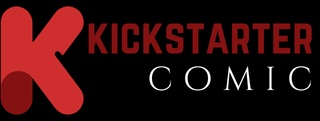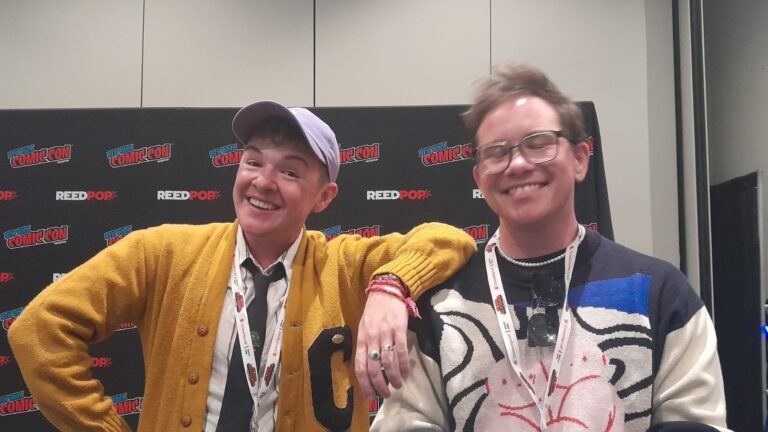Written by Jeremy Fascaldo
On Friday at New York Comic Con, creative couple N.D. Stevenson (Nimona, She-Ra and the Princesses of Power, Scarlet Morning) and Lee Knox Ostertag (Witch Boy, Deep Dark, House of Owls) discussed their experiences in the industry.
Stevenson and Ostertag talked about the original comic and the projects the two have worked on over the years. Ostertag praised Stevenson’s original comic book Nimona and his recent prose debut, Scarlet Morning.
Ostertag revealed that he is currently writing a queer book about the Victorian era, and talked about how magical the process of creating comics is, using his obsession with the Victorian era.
The conversation then turned to how the country is descending into fascism. Both authors have books that have already been banned or are currently being challenged. I and many other creators, especially BIPOC, have successfully addressed this issue. Mr. Ostertag and Mr. Stevenson happened to be among the many who spoke out about the expansion of book banning at New York CC, held during this year’s Banned Books Week.
Ostertag and Stevenson also spoke about their experience working in television animation and how it was very different from working in comics. Stevenson attested to this when discussing how much he ran around as showrunner on DreamWorks Animation’s She-Ra and the Princesses of Power.
Ostertag mentioned the creative freedom he had while writing Disney’s The Owl House. Unfortunately, while She-Ra and The Owl House were both great LGBTQ+ representations, just a few years later we saw a shift in tone in how queerness was written on television.
Amity and Luz embrace at Disney’s Owl House
Despite these challenges, the authors said they still have the freedom to write the book. Stevenson said that while it may be scary now, it will be amazing next time. He added that we are all in this together and as we experience life and new things, it is important to help create work that will help us cope with these emotions.
Other highlights of their “fireside chats” included asking each other questions about the creative process and what they had learned from each other.
Stevenson said reading interesting books helps him as a creator, and Ostertag talked about some of the queer writers he discovered while researching his own book. He shared his concern that the Internet would never be preserved in any meaningful way, and said it was important to him that we start relying more on books and physical media. Ostertag says it’s easier to obtain and has a more magical feel.
When the conversation reached its halfway point, Mr. Stevenson and Mr. Ostertag took questions from the audience. One person asked transgender creators if they were concerned about their old names appearing in works published after changing their names. They both said it didn’t bother them at all.
Another fan asked about the pair’s favorite pirate and Victorian era facts. Mr. Stevenson said he has long loved pirates and that some of the research he has done on them inspired his prose dualism, “Scarlet Morning,” published by Scholastic.
Ostertag said some of her favorite Victorian stories are about two women, Fanny and Stella, who are arrested for impersonating women in 1860s England. However, the jury did not convict. According to Lee, the jury should have had Fanny and Stella murdered. Additionally, Lee shared his favorite story about one of his favorite celebrities, Oscar Wilde.
One cosplayer asked about the couple’s creative process and their advice for when they get stuck. They both responded that they were always stuck. Stevenson helps himself by lying on the ground to help with creative blocks. Ostertag said that sometimes getting stuck in the creative process is like trying to solve a maze and reaching a dead end, and you just have to put yourself through it. Sometimes you’re trying to process things and aren’t ready to tell your story until the time is right.
Interior art for Ostertag’s graphic novel The Deep Dark
I asked Stevenson and Ostertag what advice they have for people trying to make a living doing what they love. Ostertag and Stevenson said they started making webcomics during the golden age of webcomics, which helped them get on board. Both said creators should look for art that’s being made now, like indie animation. People are trying to create a path to achieve their dreams, but finding that path requires a willingness to take risks.
Stevenson and Ostertag also said it’s important to own the work you’re creating — to own the actual rights. Stevenson said how grateful he is to have his own property and how valuable it is for creators to get the chance. He also said that if someone gives you a chance to be free, be free.
The mediums of comics and animation continue to evolve as creators of different races, genders, sexualities, abilities, and class backgrounds create art that is important to them. I expect these industries to flourish in the coming decades, especially as people like Stevenson and Ostertag present their work to the world.
Stay tuned to The Beat for more coverage of NYCC ’25.
Something like this:
Like loading…


